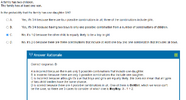Hey mate, this really tripped me and a lot of other people when we were doing the UCAT last year. A famous commercial prep company always said Some is greater than or equal to one in their answers. But the official definitions on the official UCAT website say Some is "An undetermined number being more than one but less than all. A part of it, not all of it." so it excludes 1 as you say.I've been getting some varied information about these tricky UCAT definitions. Does "some" mean 1-99 inclusive, or does it exclude 1? Would really like to clear this up as I often become torn between Y/N because of this detail!
I decided to stick to the official definition, and the official definition is what I used on test day. I remember going through the official practice question banks and mocks to see if I could find a question that could clarify this but to my memory I failed in finding a question like that which is sad. We just gotta trust UCAT will use the official definition in their questions, (content removed).
Last edited by a moderator:


